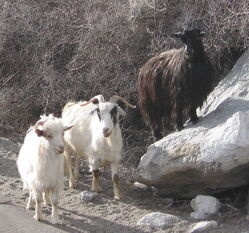
What is Pashmina?
Pashmina is a fine type of cashmere wool. The name comes from Persian: پشمینه pašmina, meaning "made from wool". Traditionally, the wool comes from a number of different breeds of pashmina goat (Capra hircus) in Kashmir region of the Himalayas. Goats used for pashmina naturally shed their winter coat every spring. This undercoat, called ikat (pronounced "ee-cot"), is collected by combing the goat, not by shearing as in other fine wools. One goat sheds approximately 80–170 gram (3–6 ounces) of the fiber per year.
Authentic Pashmina fibers are finer and thinner (12-15 microns) than typical cashmere. Pure pashmina is a rather gauzy, open weave, as the fiber cannot tolerate high tension. The most popular pashmina fabric is a 70% pashmina/30% silk blend which is tightly woven, has an elegant sheen and drapes nicely, but is still quite soft and light-weight. Cotton and synthetic blends are also common. Pashmina is known for softness, light weight, anti-wrinkle and warmth. Avoid scarves made in China and containing Viscose as this is fully synthetic and wont provide the warmth and softness of the real thing.
Where are they made?
The textiles are traditionally made in Kashmir and Nepal on the Tibetan Plateau in the Himalayan mountain range. They are hand-spun, -dyed and -woven into lightweight scarves, wraps, and throws.
When did it begin?
Woven woolen shawls made in Kashmir are mentioned in Afghan texts and Indus Valley Civilizations (3rd Century BCE - 1300 BCE). The founder of the pashmina industry is traditionally held to be the 15th century Mugal ruler of Kashmir, Zayn-ul-Abidin, who introduced weavers from Central Asia along the silk road during the Renaissance. Pashmina shawls have been worn by the royalty and the elites in the region for centuries. Pashmina blankets were also vital additions to a wealthy women's dowry in India, Pakistan and Nepal.
Pashmina is a fine type of cashmere wool. The name comes from Persian: پشمینه pašmina, meaning "made from wool". Traditionally, the wool comes from a number of different breeds of pashmina goat (Capra hircus) in Kashmir region of the Himalayas. Goats used for pashmina naturally shed their winter coat every spring. This undercoat, called ikat (pronounced "ee-cot"), is collected by combing the goat, not by shearing as in other fine wools. One goat sheds approximately 80–170 gram (3–6 ounces) of the fiber per year.
Authentic Pashmina fibers are finer and thinner (12-15 microns) than typical cashmere. Pure pashmina is a rather gauzy, open weave, as the fiber cannot tolerate high tension. The most popular pashmina fabric is a 70% pashmina/30% silk blend which is tightly woven, has an elegant sheen and drapes nicely, but is still quite soft and light-weight. Cotton and synthetic blends are also common. Pashmina is known for softness, light weight, anti-wrinkle and warmth. Avoid scarves made in China and containing Viscose as this is fully synthetic and wont provide the warmth and softness of the real thing.
Where are they made?
The textiles are traditionally made in Kashmir and Nepal on the Tibetan Plateau in the Himalayan mountain range. They are hand-spun, -dyed and -woven into lightweight scarves, wraps, and throws.
When did it begin?
Woven woolen shawls made in Kashmir are mentioned in Afghan texts and Indus Valley Civilizations (3rd Century BCE - 1300 BCE). The founder of the pashmina industry is traditionally held to be the 15th century Mugal ruler of Kashmir, Zayn-ul-Abidin, who introduced weavers from Central Asia along the silk road during the Renaissance. Pashmina shawls have been worn by the royalty and the elites in the region for centuries. Pashmina blankets were also vital additions to a wealthy women's dowry in India, Pakistan and Nepal.